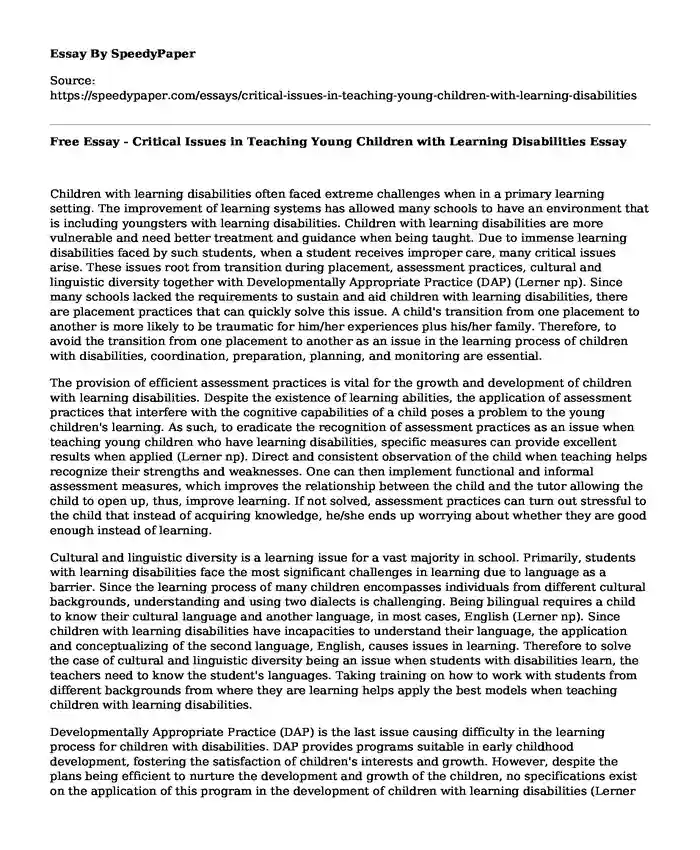
| Essay type: | Critical analysis essays |
| Categories: | Learning Knowledge Child development |
| Pages: | 3 |
| Wordcount: | 632 words |
Children with learning disabilities often faced extreme challenges when in a primary learning setting. The improvement of learning systems has allowed many schools to have an environment that is including youngsters with learning disabilities. Children with learning disabilities are more vulnerable and need better treatment and guidance when being taught. Due to immense learning disabilities faced by such students, when a student receives improper care, many critical issues arise. These issues root from transition during placement, assessment practices, cultural and linguistic diversity together with Developmentally Appropriate Practice (DAP) (Lerner np). Since many schools lacked the requirements to sustain and aid children with learning disabilities, there are placement practices that can quickly solve this issue. A child's transition from one placement to another is more likely to be traumatic for him/her experiences plus his/her family. Therefore, to avoid the transition from one placement to another as an issue in the learning process of children with disabilities, coordination, preparation, planning, and monitoring are essential.
The provision of efficient assessment practices is vital for the growth and development of children with learning disabilities. Despite the existence of learning abilities, the application of assessment practices that interfere with the cognitive capabilities of a child poses a problem to the young children's learning. As such, to eradicate the recognition of assessment practices as an issue when teaching young children who have learning disabilities, specific measures can provide excellent results when applied (Lerner np). Direct and consistent observation of the child when teaching helps recognize their strengths and weaknesses. One can then implement functional and informal assessment measures, which improves the relationship between the child and the tutor allowing the child to open up, thus, improve learning. If not solved, assessment practices can turn out stressful to the child that instead of acquiring knowledge, he/she ends up worrying about whether they are good enough instead of learning.
Cultural and linguistic diversity is a learning issue for a vast majority in school. Primarily, students with learning disabilities face the most significant challenges in learning due to language as a barrier. Since the learning process of many children encompasses individuals from different cultural backgrounds, understanding and using two dialects is challenging. Being bilingual requires a child to know their cultural language and another language, in most cases, English (Lerner np). Since children with learning disabilities have incapacities to understand their language, the application and conceptualizing of the second language, English, causes issues in learning. Therefore to solve the case of cultural and linguistic diversity being an issue when students with disabilities learn, the teachers need to know the student's languages. Taking training on how to work with students from different backgrounds from where they are learning helps apply the best models when teaching children with learning disabilities.
Developmentally Appropriate Practice (DAP) is the last issue causing difficulty in the learning process for children with disabilities. DAP provides programs suitable in early childhood development, fostering the satisfaction of children's interests and growth. However, despite the plans being efficient to nurture the development and growth of the children, no specifications exist on the application of this program in the development of children with learning disabilities (Lerner et al.,). The exclusion of precise guidelines provides a challenge in the erudition ability of children with disabilities. As such, when learning in school, children without disabilities are more likely to succeed and understand the taught concepts better. Modification of the DAP guidelines is not enough to help children with disabilities. Instead, the creation of instructions should align with the needs and requirements of children with disabilities in school. The children will feel included and develop a sense of self-love, acceptance, growth, and learn more as they grow.
Works Cited
Lerner, Janet W., et al. Preschool Children with Special Needs: Children At-risk, Children with Disabilities. Allyn & Bacon, 1998.
Cite this page
Free Essay - Critical Issues in Teaching Young Children with Learning Disabilities. (2023, Aug 24). Retrieved from https://speedypaper.net/essays/critical-issues-in-teaching-young-children-with-learning-disabilities
Request Removal
If you are the original author of this essay and no longer wish to have it published on the SpeedyPaper website, please click below to request its removal:
- Essay Example: Conversation vs. Speeches
- Learning Through Music - Free Paper Example
- Research Paper Sample on the Use of Music in Teaching and Learning
- Essay Example on the Lesson Learning Objectives
- Essay Sample on Mandated Curriculum for Training Children
- Free Paper Example: Waste Management Lesson Plan
- Paper Example: The Role of the School Nurse as Educator
Popular categories




